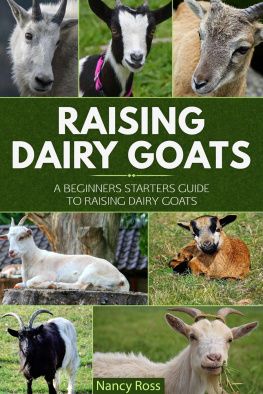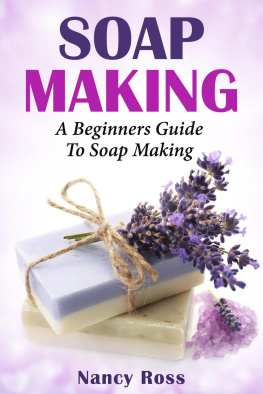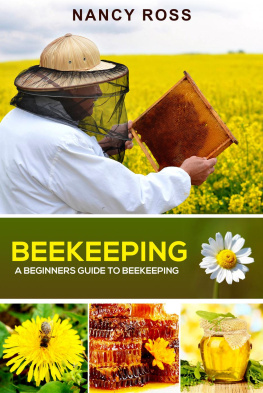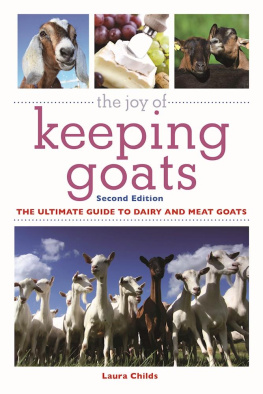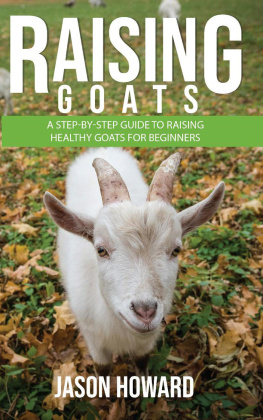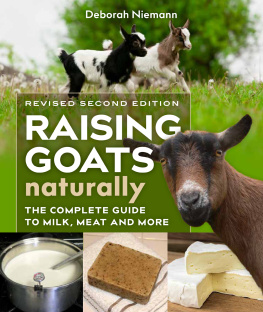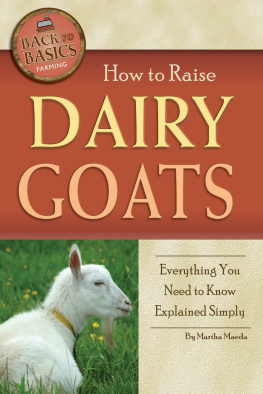While every precaution has been taken in the preparation of this book, the publisher assumes no responsibility for errors or omissions, or for damages resulting from the use of the information contained herein.
RAISING DAIRY GOATS: A BEGINNERS STARTERS GUIDE TO RAISING DAIRY GOATS
First edition. July 5, 2017.
Copyright 2017 Nancy Ross.
Written by Nancy Ross.
10 9 8 7 6 5 4 3 2 1
Raising Dairy Goats
A Beginners Starters Guide to Raising Dairy Goats
Nancy Ross
Table of Contents
Introduction
A re you looking for a pastime that is fun and will provide you with a good return while getting you outside and connected to nature? Do you like to have some fresh milk but dont really want the hassle of having to take care of those big cows? If this sounds like something that would interest you, it is time to check out how to raise dairy goats for beginners and all of the information found in this guidebook.
There is so much information that you will want to learn about when it comes to raising your own dairy farms. This guidebook will provide you with a lot of that information so you are sure to get going on the right path. We will discuss some of the basics of having a goat, how to pick out the right breed, how to set up a good shelter and grazing area for the goats, and even how to choose the best animals to bring home. We will then move on to some of the daily duties that you have to keep up with for your goats to stay happy and healthy. Some of the things that are included in this consist of milking the goats, breeding the goats, preventing diseases, and some tips and tricks to help take care of a goat.
When it comes to picking out an animal to add to your home that will provide you with more animals for the herd and some tasty milk, goats are a good choice to go with. They are pretty easy to work with and wont need a lot of food or anything else. As long as you give them some attention and the food that they are looking for, you will get some good results. When you are ready to get started on your journey for raising dairy goats, make sure to read this guidebook and get all of the information that is needed to help you to get started.
Chapter 1: Goat Basics
B efore you get too far into picking out your own goats, it is important that you are prepared for this great endeavor. First, you need to make sure that you have the amount of room that is necessary to take care of your goats. Goats need some room to move around and feel free. If you stick them in pens that are close together, you are going to end up with a lot of issues in the process and this really is not fair to the goats you are working with. You also need to make sure that you have the time that is needed to take care of and pay attention to the goats. It is not a good idea to get the goats and then abandon them all day long just to play with them when you feel like it. These goats are going to be a full commitment, so make sure you are ready to handle this.
So now that we have taken the time to go through a few of the requirements that are needed concerning goats, it is time to go through some of the basics as well. It is important to know a few of these basics if you would like to have the chance of doing well with these goats. The first thing that you should understand when getting your goats is that goats are often herd animals. You arent going to be able to pick just one, and usually you will need to work with at least three or four at the same time. Your goats will like to be social and interact with each other, so consider that before getting started.
Another thing to consider is that most goats are determined and even crafty animals. And no matter how much you prepare for this ahead of time, they are still going to find a way to trick you. Goats are smart and they know how to get around, under, and over gates and they will learn how to open the gate up. When you are creating the fencing and the housing that you want to use, you should always add in more effort rather than less. Goats can often jump much higher and are stronger than you would guess.
When starting out, it is always best to go with more females than males. Most of the herds that you will see will start out with three females to one male. If you are able to start out with four goats, it is best to stick with this ratio to keep things easy. When you house the male and female goats together, they are going to breed so keep this in mind. Most does are going to give birth to just one kid at a time, but it is not uncommon to get litters of two and three sometimes as well.
For the most part, kidding, or the process of goat birthing, is going to be trouble free. This is good because kidding is very essential if you are raising these goats for their milk. The gestation of a goat is going to last about 150 days. As a goat owner, you should spend some time learning more of the specifics about kidding to make sure that you can help the kid and the doe during this process. For your first time, you should consider having a professional around, or at least someone who has gone through this process in the past. For example, this may seem a bit strange to you but it is considered normal for the doe to eat her placenta when she is done giving birth.
After the birthing process, be prepared to see the doe leave their kids. This is not a bad thing and it is not a sign that the doe is abandoning their young, so dont get too worried about this. Rather, the doe is leaving because they know that they need to get something to eat before they are able to start the nursing process. Once they have gotten their food, they will be back.
The doe will be able to produce about six pounds of milk each day, once they have begun the lactating process. After about three months, the kids are going to be weaned, so then you will be needing to take the milk. Most does will be able to produce this milk for about three years once they are done kidding just once.
For the most part, your goat is not going to live more than 12 years. Often you will find that the does will live a bit longer than the bucks, but it often depends on how many times the doe has had a kid. Reproduction can put on some strain to the system of your goat, so if they have had a lot of kids, they are not likely to live as long.
Making a Shelter
B efore you bring the goats home, you will need to provide them with a nice shelter to live in. You can leave an opening in it or some windows so that the area can be ventilated during the hot summer months. You should also consider getting some materials that are pretty sturdy so that the goats are not able to get out of their area. Make it plenty big enough so that all of the goats are able to fit in and dont crowd each other. You can even consider adding on an extra shelter for the does and their kids after birth to keep them comfortable as well.
Picking out the goat
I t is an exciting time to go out and pick out the goat that you would like to bring home. But you do need to be careful that you are picking a goat that is healthy and happy and will not get all sick on you right when you bring them home. It is always a good idea to ask a lot of questions in the process and take a good look at the goats before making a purchase. If you have someone who knows a lot about goats or who has raised them before, bring them along. It is always good to have a few extra eyes around to look over things to help you pick out the perfect herd.
Feeding the Goats
A nother thing that you will need to pay attention to is the process of feeding the goats. Your goats are fairly self-sufficient with this, but you can provide them with a little bit of food to make it easier. For example, your goats are going to enjoy eating grass and plants that are in their grazing area. You should put up a pretty sturdy fence around the goats. This is going to help to keep them in their place so that they wont wander off, and can show the goats where they are allowed to graze without ruining your whole yard.

